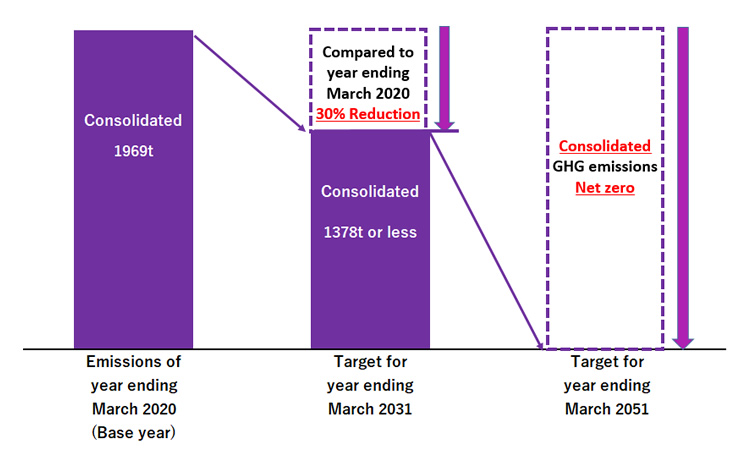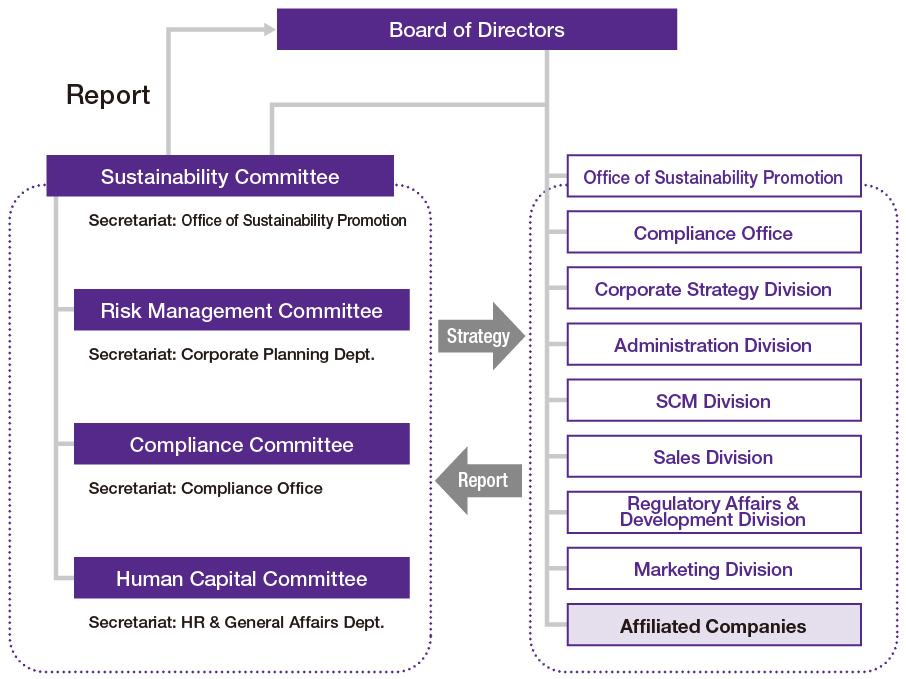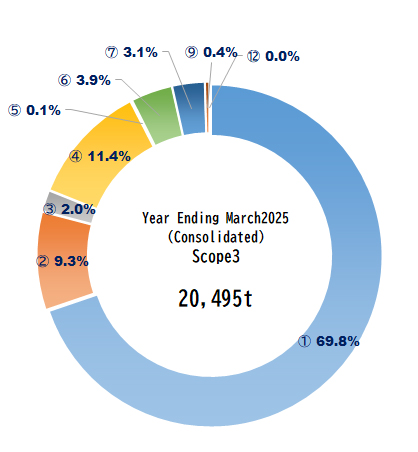Reduction of environmental load
Environmental Policy of JMDM Group
Basic Philosophy
JMDM Group positions environmental initiatives as an important management issue and, as a responsible member of society, aims to be a company that is trusted by society through contributing to the preservation of the global environment and the formation of a circular society.
-
Compliance with applicable Laws and Regulations
We will comply with international declarations, conventions, and treaties related to environmental conservation, as well as the laws and regulations of the countries and regions in which we operate.
-
Climate Change Response
We take climate change seriously, reducing greenhouse gas emissions and promoting the efficient use of energy.
-
Prevention of Environmental Pollution
We strive to prevent environmental pollution and properly manage chemical substances, etc. to prevent any impact on the environment.
-
Promotion of Resource Recycling
We will contribute to the formation of a recycling-oriented society by promoting sustainable use of resources, reduction of resource consumption, and reduction and recycling of waste.
-
Effective Use of Water Resources
We will strive to conserve water resources through efficient use of water.
-
Disclosure of Information
We will strive to proactively disclose information related to the environment.
April 1, 2023
Japan Medical Dynamic Marketing, INC.
Representative Director and President
Toshiyuki Hironaka
Established in January 1, 2023
Response to TCFD Recommendations
Based on our management philosophy of “contributing to healthcare through the development and marketing of leading-edge, superior medical devices,” we will identify materiality issues from a long-term perspective, fulfill our corporate social responsibility (CSR) through ESG activities, and pursue sustainable growth while contributing to the SDGs (Sustainable Development Goals).
In March 2022, we expressed our support for the TCFD* recommendations and joined the TCFD Consortium*, a group of companies and financial institutions that support the TCFD. We will take climate change seriously, deepen our understanding of the risk and risks that opportunities affect our business, and proactively disclose our efforts to address climate change. The TCFD recommendation recommends disclosing information on climate change in the areas of 1. Governance, 2. Strategy, 3. Risk management, and 4. Indicators and targets. We will analyze scenarios, assess risks and opportunities associated with climate change, and disclose information in line with the four recommended disclosure items in accordance with the TCFD recommendations.


*1 TCFD: Task Force on Climate-related Financial Disclosures (TCFD)
Task Force on Climate-related Financial Disclosures. A task force established by the Financial Stability Board (FSB).
The task force was established by the Financial Stability Board (FSB) with the objective of understanding and disclosing the financial implications of the risks and opportunities posed by climate change.
The company publishes recommendations on
TCFD website:https://www.fsb-tcfd.org/
*2 TCFD Consortium
A forum for discussing effective information disclosure by companies and efforts to link the displayed information to appropriate investment decisions by financial institutions, etc.
Established in 2019, the TCFD will be promoted by companies and financial institutions that support the TCFD’s propositions.
570 organizations are participating as of March 25, 2022.
TCFD Consortium website:https://tcfd-consortium.jp
1.Governance
Our Board of Directors believes that addressing sustainability issues (e.g., consideration of climate change and other global environmental issues, respect for human rights, fair and appropriate treatment of employees and their health and working environment, fair and appropriate transactions with suppliers, and risk management for natural disasters) will not only reduce our business risks but also provide us with profit opportunities. We recognize that this is an important materiality, and we are responsible for addressing it. The Sustainability Committee* discusses and evaluates our response to the TCFD and reports to the Board of Directors twice a year, and the Board of Directors approves, supervises, and provides guidance based on the Committee’s report.
※Sustainability Committee
The committee is chaired by the President and Chief Executive Officer and consists of executive officers, the head of the Sustainability Management Office, and a person appointed by the chairperson.
Sustainability Management Structure
2.Strategy
① Scenario analysis
We use a scenario analysis approach to identify climate change-related risks and opportunities, both transitional and physical. In the scenario analysis, we used “scenarios” published by the International Energy Agency (IEA) and other organizations to examine how our business would be affected. The scenario analysis conducted this time covered the entire value chain from import, development, manufacturing to sales of products and services in Japan (on a non-consolidated basis), and considered and examined the impacts as of 2030, using two scenarios: a 4°C scenario and a 1.5°C scenario. We will continue to improve the accuracy of our scenario analysis by expanding it to include overseas (affiliated companies) and conducting it on an ongoing basis. The results of our deliberations will be reported to the Board of Directors to enhance our resilience to an uncertain future.
| 【 4°C Scenario 】 Temperature rise exceeds 4°C and climate change If the impact becomes apparent |
【 1.5°C Scenario 】 Temperature rise is kept below 1.5°C, and If the entire world transitions to a low-carbon society |
|
|---|---|---|
| Scenario Analysis | As global warming progresses and average temperatures rise due to only limited implementation of policies and regulations that promote low carbon emissions, our working environment is expected to deteriorate due to heat stress. We are also aware that the spread of infectious diseases associated with rising temperatures may lead to a decrease in our product sales as surgeries for acute diseases are prioritized and chronic disease surgeries for joint replacement and spinal fusion are postponed or cancelled. |
The world is expected to transform into a more disciplined society as economic activity increases with decarburization and low carbon in mind. In line with this, the introduction of a carbon tax created by tighter regulations and the market’s growing environmental consciousness will require the use of environmentally friendly materials aimed at a recycling-oriented society, and the cost of dealing with these issues is expected to be amplified. The Company intends to contribute to a recycling-oriented society by promptly obtaining information from the government that promotes decarburization, strengthening investments in energy conservation and renewable energy, and implementing measures that are consistent with the sustainable orientation of customers and other stakeholders. |
② Risks and opportunities associated with climate change
Scope of coverage: Domestic only (on the Company’s non-consolidated basis)
Time: Short-term (within 1 year), medium-term (over 1 year to 3 years), and long-term (over 3 years)
Impact: Small (within 0.5 billion yen), Medium (over 0.5 billion yen to 0.2 billion yen), Large (over 0.2 billion yen)
| Classification | Contents | Period | Degree of Influence |
Response Policy | ||
|---|---|---|---|---|---|---|
| Risk | Transition | Policy Regulation |
Risk of increased energy and procurement costs due to the introduction of a carbon tax |
Medium-term | Small |
Continuous improvement of energy efficiency |
|
Risk of incurring capital investment costs due to replacement of equipment, etc., |
Short term ~Long-term |
Small | ||||
| Reputation |
Risk of impact on stock price due to delay in disclosing information on climate change response |
Short-term ~Medium-term |
Small | |||
| Physics | Acute |
Risk of distribution delays and opportunity losses due to damage to buildings, facilities, |
Short-term | Big | ||
| Chronic |
Risk of sales decrease due to decline or stagnation in the functioning of |
Medium-term ~Long-term |
Big | |||
| Opportunity | Resource Efficiency |
Cost savings through improved energy efficiency |
Short term ~Long-term |
Small | ||
| Reputation |
Enhance corporate value through proactive information disclosure |
Short term ~Medium-term |
Small | |||
| Products and Services |
Increased demand through product center satelliteization (shorter logistics lead times) |
Short term ~Long-term |
Small | |||
|
Provision of products, medical tools, etc. that contribute to reducing environmental impact, etc. |
Long-term | Big | ||||
| Resilience |
Stabilization of product supply through decentralized storage of inventory |
Short term ~Long-term |
Small | |||
3.Risk Management
We manage key management risks by promoting the activities of the Risk Management Committee in accordance with the Risk Management Regulations. Climate change risk is also positioned as a management priority risk, and risk analysis is conducted. The Sustainability Committee works with the Risk Management Committee and Compliance Committee, which are subordinate organizations, to identify sustainability-related risks and deliberate appropriate responses, and reports to the Board of Directors twice a year. The Board of Directors receives reports from the Sustainability Committee on the status of risk management and responses, and provides supervision and guidance.
4.Indicators and Targets
We have set our climate change index as greenhouse gas (GHG) emissions, and based on the FY2020 Scope 1 and 2 GHG emissions, we have set our reduction target for FY2030 at 30% below the FY2020 level, with the goal of achieving “zero GHG emissions” in FY2050. The company will be responsible for the following.
(Consolidated)Scope 1.2 GHG emissions: t-CO₂

We aim to achieve zero GHG emissions by 2050 by systematically implementing initiatives to reduce GHG emissions, including the promotion of energy conservation at all of our bases, procurement of electricity derived from renewable energy sources, and the phased introduction of electric vehicles.
| Scope1 | Scope2 | Total Amount | |
|---|---|---|---|
| 2020 (Base year) | 1,200 | 769 | 1,969 |
| 2021 | 1,150 | 792 | 1,942 |
| 2022 | 1,256 | 896 | 2,152 |
| 2023 | 1,285 | 849 | 2,134 |
| 2024 | 1,238 | 505 | 1,743 |
| 2025 | 990 | 565 | 1,555 |
(Consolidated)Scope 1.2.3 Actual GHG emissions: t-CO₂
| Scope1 | Scope2 | Scope3 | Total Amount | |
|---|---|---|---|---|
| 2020 (Base year) | 1,200 | 769 | 28,167 | 30,136 |
| 2021 | 1,150 | 792 | 22,030 | 23,972 |
| 2022 | 1,256 | 896 | 26,002 | 28,154 |
| 2023 | 1,285 | 849 | 28,064 | 30,198 |
| 2024 | 1,238 | 505 | 22,240 | 23,983 |
| 2025 | 990 | 565 | 20,495 | 22,050 |
(Consolidated) Scope3
| ①Products and Services Purchased | 14,305 | 69.8% | |
| ②Capital Goods | 1,900 | 9.3% | |
| ③Fuel and energy related activities | 412 | 2.0% | |
| ④Transportation and Delivery (upstream) | 2,334 | 11.4% | |
| ⑤Waste from Operations (Upstream) | 23 | 0.1% | |
| ⑥Business Trip | 803 | 3.9% | |
| ⑦Employer Commute | 629 | 3.1% | |
| ⑧Leased Assets (Upstream) | – | – | ※2 |
| ⑨Transportation, Delivery (Downstream) | 87 | 0.4% | |
| ⑩Processing of Sold Products | 0 | 0 | ※2 |
| ⑪Use of Products Sold | – | – | ※2 |
| ⑫Disposal of Sold Products | 2 | 0.0% | |
| ⑬Leased Assets (Downstream) | – | – | ※2 |
| ⑭Franchise | – | – | ※2 |
| ⑮Investment | – | – | ※2 |
| Total Amount | 20,495 | 100.0% |
|---|
(※2)Columns ⑧⑪⑬⑭⑮ are not calculated because there are no streets.



